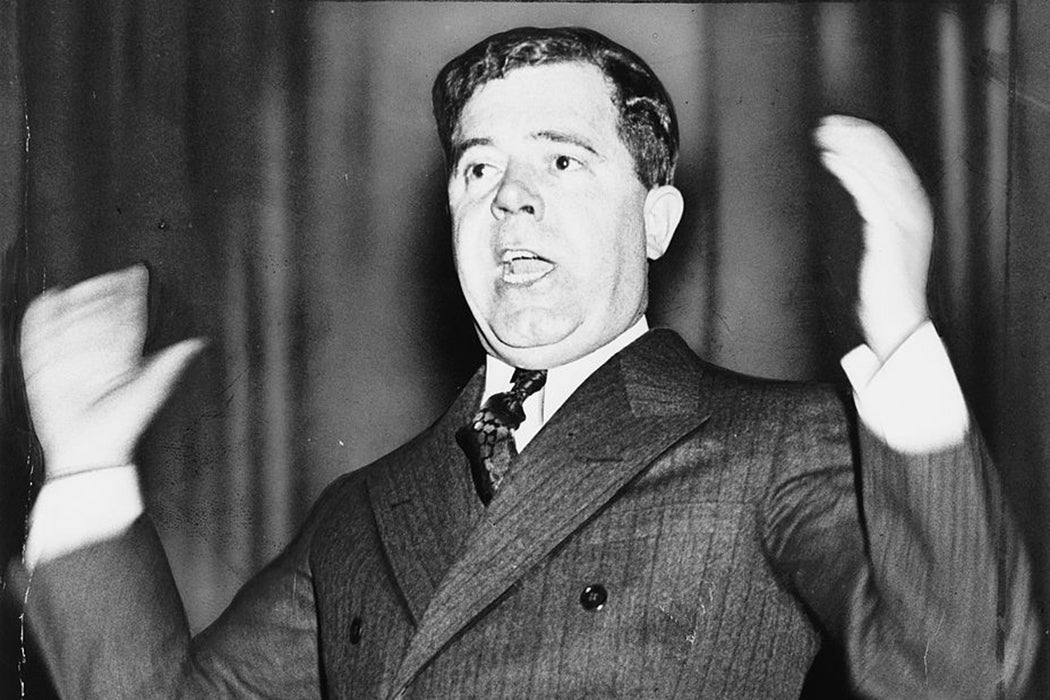Huey Long, senator and governor of Louisiana, was assassinated on September 10th, 1935. He was only 42 years old. His short political career was defined by a charismatic persona that heartened his voters and provoked fear and loathing among his political opponents. According to most official versions of the events, Dr. Carl Weiss, the son-in-law of one of Long’s political opponents, fired the fatal bullets at the Louisiana State House in Baton Rouge.
Long railed against the rich and elites in the media. He honed a populist message that made him a national figure. His enemies labled him a fascist, while his supporters viewed him as a savior for a country mired in depression and turmoil.
Long sought to improve conditions for the poor people of Louisiania who made him governor in 1928, particularly those from rural regions. Glen Jeansonne, a Louisiana historian, notes that a secret to Long’s success was making “the common man feel important.” He pioneered barnstorming campaigning, visiting isolated spots in the state where politicians had never bothered to trod. On Election Day, voters remembered. And he seemed to remember those votes: Long brought highways, public schools, publicly-financed textbooks, and charity hospitals around the state. He took on Standard Oil and the established political machine.
But he had a power-hungry side, too, and soon established his own machine. A symbol of his reign was a skyscraper-like state capitol he built in Baton Rouge, a project created by a system of patronage that reenforced his power. By the height of his term as governor, Long ran the state as his own personal fiefdom.
When he successfully ran for U.S. Senate in 1932, his lust for power was so great that he arranged to keep both jobs as governor and senator, only eventually being forced to pass the gubernatorial baton to a hand-picked crony. Even while a senator, Long continued to exert his influence on the state house.
As a senator, Long burnished his national profile. His “Share the Wealth” plan proposed that no one would make more than a million a year. (Historians note that at the time there were only about 50 or so wage earners at that level). He promised a $30 retiree monthly pension, free college education, bonuses for veterans, and a 30-hour work week to increase employment.
Long’s power and influence grew, and, at the time of his assassination, he was considered a serious candidate to oppose fellow Democrat Franklin Roosevelt in the 1936 presidential election. He even wrote a book, My First Days in the White House, detailing his plans. Most historians doubt that Long could have won the 1936 presidential election as an independent candidate, but note that he could have drawn enough voters away from Roosevelt to give the election to the Republicans. Some credit Long with forcing Roosevelt to propose Social Security as a way to counteract his leftist challenger from the South.
Jeansonne argues that Long was a charlatan, both insincere and ineffective, who knew his schemes were ridiculous but championed them anyway. He shook up the U.S. Senate, breaking many of its established customs, including meeting foreign diplomats in his silk pajamas and openly keeping a mistress; according to scores of biographies and thinly-disguised novels Long was known for his womanizing ways. If he had not been assassinated, it was likely that he would have been indicted for federal income tax evasion.
Weekly Digest
Long illustrated both the power and the limitations of a political agenda focused on blaming elites for the nation’s woes. He was a perfect match for America’s troubled Depression Era, offering solutions that were politically popular but seen by many as impractical and dangerous. As historian Courtney Vaughn notes, when the strong ignore the weak, there is always someone who “hovers in the background learning the techniques of demagoguery.”







